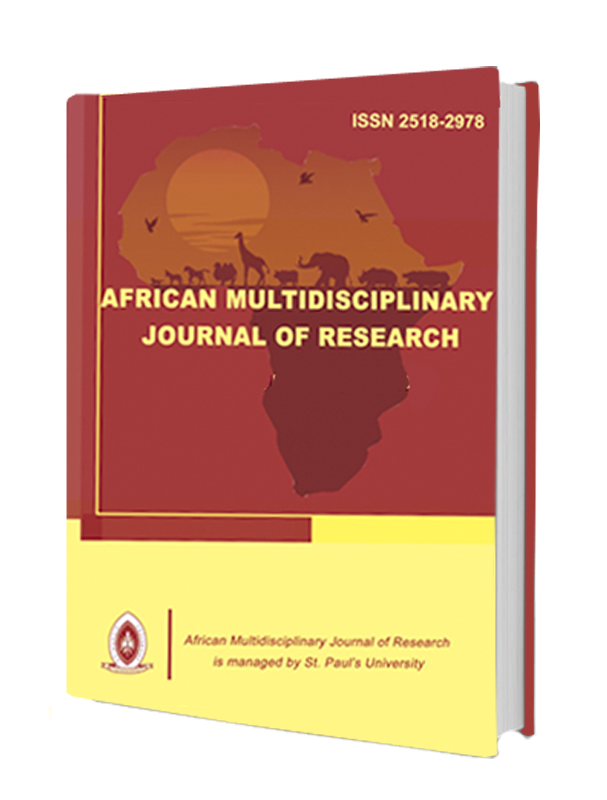The Influence of the Covid-19 Risk Communication and Community Engagement Strategy on Non-State Actors Communication Activities: A Case Study of Shining Hope for Communities (Shofco) Kenya
##plugins.themes.academic_pro.article.main##
Abstract
A Risk Communication and Community Engagement (RCCE) strategy plays a pivotal role in addressing perceptions, misinformation, and disinformation surrounding health threats, necessitating continuous communication with communities. This study investigated the impact of RCCE implementation during the COVID-19 pandemic on non-state actors, with a specific focus on Shining Hope for Communities (SHOFCO) as a case study. The primary aim was to assess how the RCCE influenced SHOFCO's communication activities amid the pandemic. Specific objectives included evaluating the effects of the COVID-19 RCCE strategy on SHOFCO's communication initiatives in the Mathare and Kibera satellite clinics, addressing misinformation and Infodemics, managing two-way communication involving feedback, and disseminating communication directives to the served communities. Employing the diffusion of innovation theory and Charles Osgood's communication model, this mixed-method research adopted a case study approach. The population size was 105 with a sample size of 63 individuals selected through purposive sampling. Data collection methods comprised questionnaires and interviews. The study revealed that RCCE strategies guide managing communication aspects during health emergencies, stressing the importance of adhering to directives to combat Infodemics and establish response mechanisms. Recommendations included sharing SHOFCO's findings with the Kenyan Ministry of Health (MoH-Kenya) to inform the restructuring of RCCE initiatives, conducting further research on the Ministry's feedback mechanism, considering diverse populations such as SHOFCO in RCCE drafting and planning, and conducting internal reviews to enhance future health threat responses. The study's outcomes hold significance for the Kenyan government, development partners, and non-state actors regarding effective communication strategies for addressing future health threats.
##plugins.themes.academic_pro.article.details##
References
- Adebisi, Y. A., Rabe, A., & Lucero-Prisno III, D. E. (2021). Risk communication and community engagement strategies for COVID-19 in 13 African countries. Health Promotion Perspectives, 11(2), 137–147. https://doi.org/10.34172/hpp.2021.18
- Adhiambo, S. (2020, August 5). Building Community Networks to Respond to the COVID-19 Pandemic in Africa through ‘Last Mile’ Initiatives. – Africa Research & Impact Network. https://www.arin-africa.org/2020/08/05/building-community-networks-to- respond-to-the-covid-19-pandemic-in-africa-through-last-mile-initiatives-authors- kennedy-mbeva-victoria-chengo-and-joanes-atela/
- Al Siyabi, H., Al Mukhaini, S., Kanaan, M., Al Hatmi, S., Al Anqoudi, Z., Al Kalbani, A., Al Bahri, Z., Wannous, C., & Al Awaidy, S. T. (2021). Community Participation Approaches for Effective National COVID-19 Pandemic Preparedness and Response: An Experience From Oman. Frontiers in Public Health, 8. https://www.frontiersin.org/articles/10.3389/fpubh.2020.616763
- Asemah, E., Nwammuo, A., & Uwaoma, A. (2022). Theories and Models of Communication (Second Edition).
- Costantino, C., & Fiacchini, D. (2020). Rationale of the WHO document on Risk Communication and Community Engagement (RCCE) readiness and response to the Severe Acute Respiratory Syndrome Coronavirus 2 (SARS-CoV-2) and of the Italian Decalogue for Prevention Departments. Journal of Preventive Medicine and Hygiene, 61(1), E1. https://doi.org/10.15167/2421-4248/jpmh2020.61.1.1502
- Dearing, J. W., & Cox, J. G. (2018). Diffusion Of Innovations Theory, Principles, And Practice. Health Affairs, 37(2), 183–190. https://doi.org/10.1377/hlthaff.2017.1104
- Fisher, R. W. S. (2004). Diffusion of innovation theory for clinical change. Medical Journal of Australia, 180(S6), S55–S56. https://doi.org/10.5694/j.1326-5377.2004.tb05947.x
- Gonah, L. (2020). Key Considerations for Successful Risk Communication and Community Engagement (RCCE) Programmes During COVID-19 Pandemic and Other Public Health Emergencies. Annals of Global Health, 86(1). https://doi.org/10.5334/aogh.3119
- Kapur, R. (2020). The Models of Communication. https://www.researchgate.net/ publication/ 344295651_The_Models_of_Communication
- Kiarie, H., Temmerman, M., Nyamai, M., Liku, N., Thuo, W., Oramisi, V., Nyaga, L.,
- Karimi, J., Wamalwa, P., Gatheca, G., Mwenda, V., Ombajo, L. A., Thumbi, S. M., Cosmas, L., Gatheca, G., Kiarie, J., Soe, K., Munyao, O., Gathiti, Z., … Gitau, S. (2022). The COVID-19 pandemic and disruptions to essential health services in Kenya: A retrospective time-series analysis. The Lancet Global Health, 10(9), e1257– e1267. https://doi.org/10.1016/S2214-109X(22)00285-6
- Lefebvre, C. (1993). Public health communication. Health Promotion International, 8(4), 241–242. https://www.jstor.org/stable/45152157
- Muthotho, J. (2020). DETERMINANTS OF CORPORATE COMMUNICATION STRATEGIES FOR DISSEMINATION OF DISEASE SURVEILLANCE RESEARCH OUTCOMES AT KENYA MEDICAL RESEARCH INSTITUTE.
- Osgood, C. E. (1964). Semantic Differential Technique in the Comparative Study of Cultures. American Anthropologist, 66(3), 171–200. https://www.jstor.org/stable/669329
- Osman, M. A. (2018). Influence Of Community Participation On Sustainability Of Development Projects By Non-Governmental Organizations In Kenya. A Case Of
- Shofco Organization In Mathare Informal Settlement. http://erepository.uonbi.ac.ke/bitstream/handle/11295/106199/Osman_Influence%
- Spring, H. (2020). Health literacy and COVID-19. Health Information & Libraries Journal, 37(3), 171–172. https://doi.org/10.1111/hir.12322
- Waithaka, A. (2021). Analysis of Behaviour Change Communication in Covid-19 Response: A Case of the Kenya Ministry of Health and Accelerating Sustainable Control and Elimination of Neglected Tropical Diseases (Ascend) Campaign in Coastal Counties. http://erepository.uonbi.ac.ke/bitstream/handle/11295/160401/Waithaka_Analysis%2 0of%20Behaviour%20Change%20Communication%20in%20Covid- 19%20Response%20-
- %20%20a%20Case%20of%20the%20Kenya%20Ministry%20of%20Health%20and% 20Accelerating%20Sustainable%20Control%20and%20Elimination%20of%20Neglec ted%20Tropical%20Diseases.pdf?sequence=1
- Wambua, S., Malla, L., Mbevi, G., Nwosu, A.-P., Tuti, T., Paton, C., Cheburet, S., Manya, A., English, M., & Okiro, E. A. (2021). The indirect impact of COVID-19 pandemic on inpatient admissions in 204 Kenyan hospitals: An interrupted time series analysis. PLOS Global Public Health, 1(11), e0000029. https://doi.org/10.1371/journal.pgph.0000029
- Wangari, E. N., Gichuki, P., Abuor, A. A., Wambui, J., Okeyo, S. O., Oyatsi, H. T. N., Odikara, S., & Kulohoma, B. W. (2021). Kenya’s response to the COVID-19 pandemic: A balance between minimising morbidity and adverse economic impact. AAS Open Research, 4, 3. https://doi.org/10.12688/aasopenres.13156.2
- Zainal, Z. (2007). Case study as a research method. https://www.researchgate.net/publication/41822817_Case_study_as_a_research_meth od
- Zhang, Y., Tambo, E., Djuikoue, I. C., Tazemda, G. K., Fotsing, M. F., & Zhou, X.-N. (2021). Early stage risk communication and community engagement (RCCE) strategies and measures against the coronavirus disease 2019 (COVID-19) pandemic crisis. Global Health Journal (Amsterdam, Netherlands), 5(1), 44–50. https://doi.org/10.1016/j.glohj.2021.02.009

